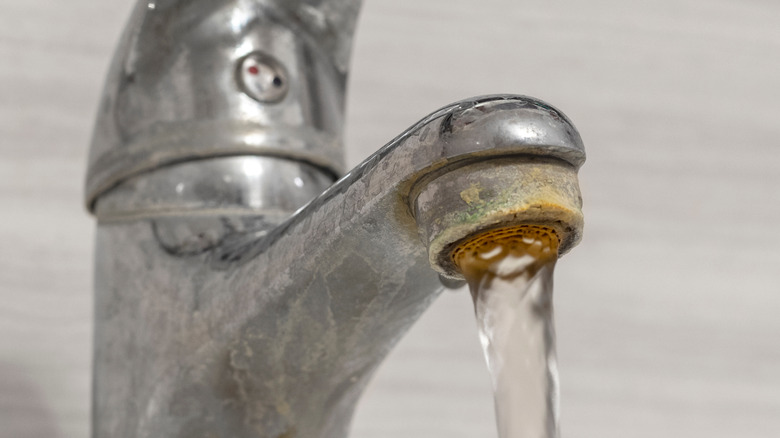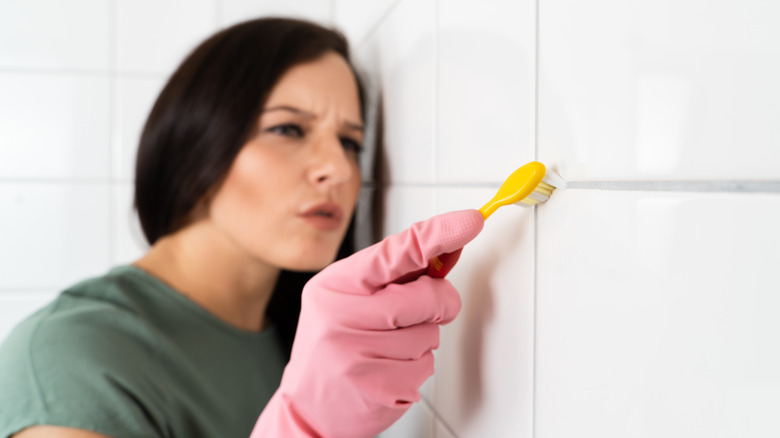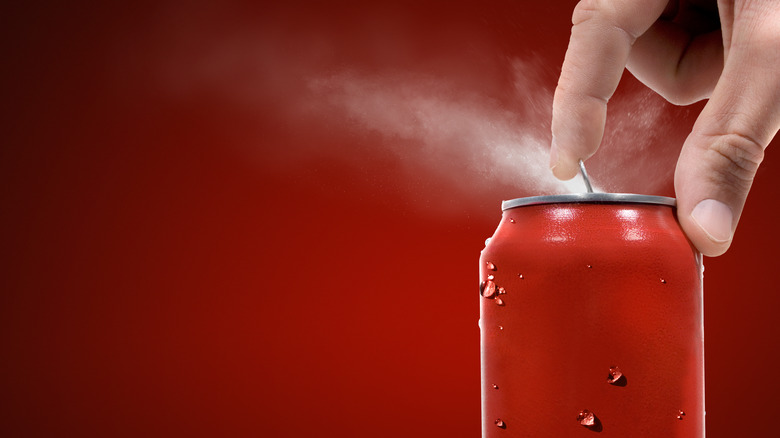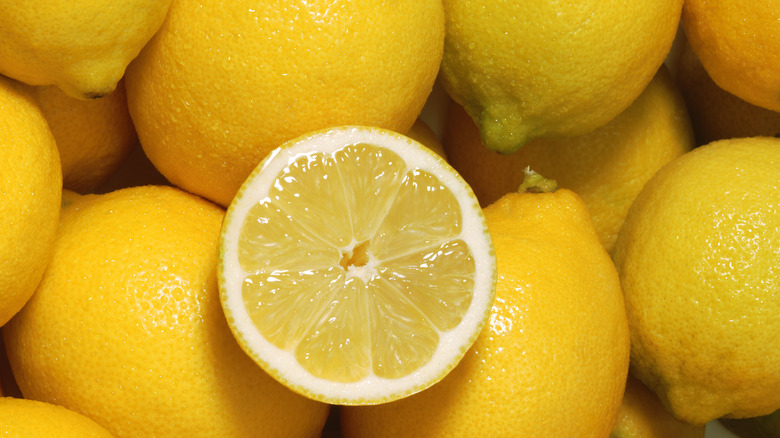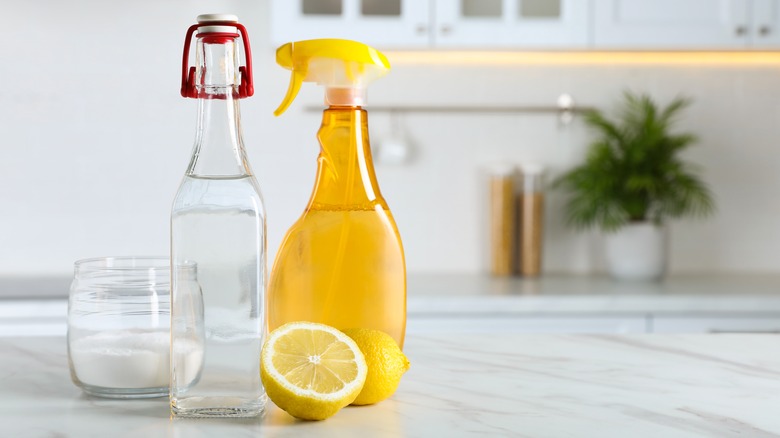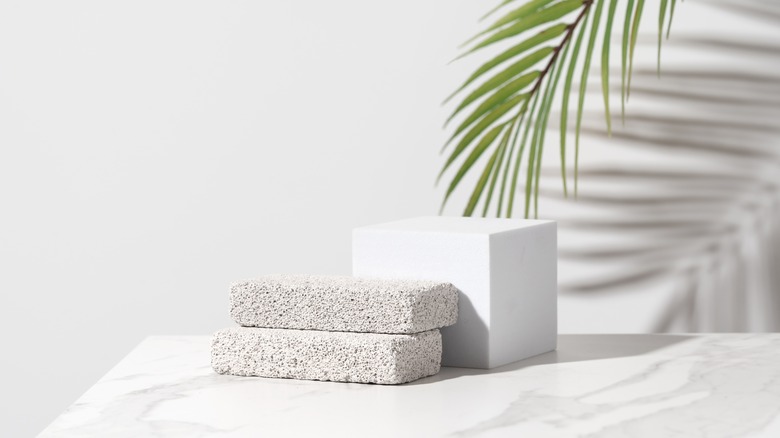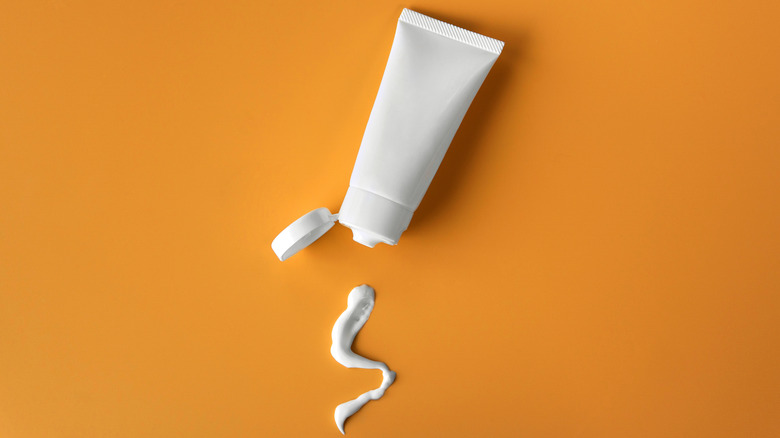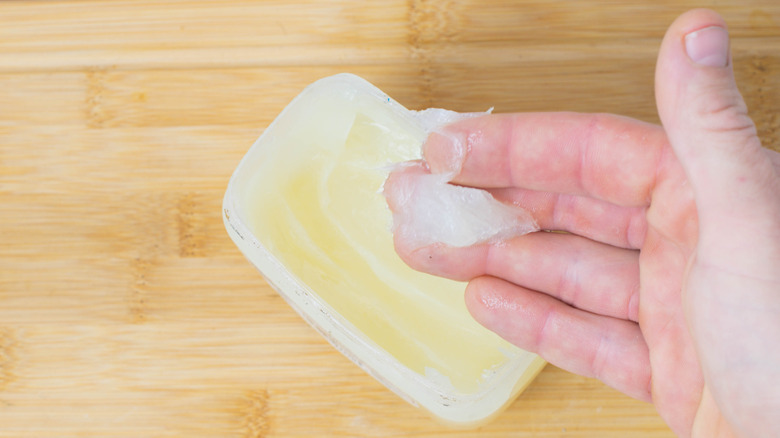7 Hacks That Remove Hard Water Stains Easier Than Ever
Have you ever noticed yellow or pink stains that build up along your bathtub, sink, faucets, or countertops? Chances are, these stains are due to hard water, caused by surplus amounts of calcium and magnesium. One of the reasons that hard water can lead to buildups and stains is that you can't remove it with soap. In fact, soap and calcium can even combine to create this difficult-to-remove residue. That's also why many common cleaning products don't work well to eradicate hard water stains.
According to Forbes, about 85% of American homes have hard water. If you're one of these, there are some simple solutions available to you. You don't have to run to the store to purchase pricey chemical cleaners or install a full-home water softener. Instead, there are a few hard water cleaning hacks that you can try. Many even use materials you probably already have on hand.
Use a toothbrush to clean hard water stains more effectively
There are a lot of different products out there that market themselves as cleaners for hard water stains. However, even if you use the right product, it won't work if you aren't using it with the right tool. When cleaning off stains, you may be tempted to reach for paper towels, microfiber cloths, or just a plain old rag. Unfortunately, none of these are abrasive enough to really combat the calcium and magnesium buildups. You need something that can really break apart the mineral residue like a toothbrush.
It may sound tedious to scrub the entire bathtub with a toothbrush, but the hard bristles work so much better than a cloth. In the end, you'll find that the process will actually be easier and faster. One of the best ways to use this hack is when cleaning out showerheads and faucets. Remove the showerhead and soak in distilled white vinegar or your favorite cleaning product, and then gently scrub away the solution with a toothbrush. The bristles will help clean out all the small spaces where the minerals from your hard water have built up.
Does Coca-Cola really work to clean hard water stains?
Using Coca-Cola to clean your toilet might sound like a wild idea, but it does work! If you've ever been in a spot where you need to clean hard water stains from a toilet, try pouring some Coke down the edges of the bowl. You'll want to pour slowly and evenly, letting it drip down the edges before going in for another round.
Then, use a toilet brush to gently scrub away the Coke and watch it take the hard water stains with it. When you have hard water, the mineral buildup can form what is called limescale. This is what causes stains, and can block pipes and wear out appliances. The acidity in Coke breaks this substance down and makes it much easier to clean.
That being said, Coca-Cola is also a very sugary drink, so it doesn't work for cleaning all hard water stains. For example, if you use it to clean out a bathtub, you'll need to use another cleaner after to remove any sticky residue. But, once again, it can be a great trick for quickly cleaning a toilet that has bad hard water stains in the bowl.
When life gives you lemons, clean the kitchen
Vinegar is often used as a common household cleaner. It is acidic, so helps break down many different kinds of stains to make cleaning easier. However, another common kitchen staple is also acidic — lemons! And, their juice does a great job of breaking down the minerals that are left behind in hard water stains. When the acid reacts with the calcium and magnesium, it eats away at the minerals so that you can scrub away the stains more easily.
In order to make this hack work, you need to let the lemon juice soak. You can rub half a cut fruit over your faucets and then let that sit, or you can fill a container with lemon juice and vinegar and soak your showerhead. Using both acids will help break apart the mineral buildup even more quickly. Then, use a toothbrush to really clean out any nooks and crannies. Otherwise, you can wipe the lemon, or lemon and vinegar, away with a cloth or a paper towel.
Make baking soda and vinegar more effective by combining them into a paste
You've probably already heard that combining baking soda and vinegar can be a great cleaner. However, turning them into a thick paste beforehand works even better. This consistency is more versatile and allows you to coat affected areas and let the solution really soak. The reason baking soda and vinegar work so well as cleaning products is that the first is a base while the latter is an acid. This means that they attack multiple types of grime. The vinegar in this solution breaks away the hard minerals, while the baking soda removes dirt and soap residue.
In order to make this cleaning paste, start by adding two parts baking soda to one part vinegar and one part water. As you're mixing, make sure you have a big enough container and work slowly. The two will have a chemical reaction and start to bubble. Let this reaction happen, and then stir what's left to create a thick paste. You can add additional vinegar or water to thin it out or extra baking soda to thicken it if needed.
Once you've made the paste, lay down a thick layer over the hard water stains you need to tackle. Let it sit for several minutes, then wipe it off. If you have a particularly stubborn stain, you can let the paste sit until it is completely dry, then use a little water to fully remove it.
Use a pumice stone for stubborn stains
Another great tool for cleaning hard water stains is a pumice stone. Real pumice stones are a kind of volcanic rock, but you can also find artificially made ones that are made from ground glass and a foaming agent. These work just as well as the volcanic variety. These are an incredibly abrasive material. This means that they can scrub away hard water stains better than almost anything else. They are especially good for cleaning porcelain or ceramic surfaces. However, you can also damage objects by using a pumice stone incorrectly.
First, you need to first soak it in water. Make sure this porous rock soaks up plenty of water so that you won't accidentally scratch whatever surface you are trying to clean. Next, test out by scrubbing very gently on a small area. This will let you know if the pumice stone is too abrasive and could cause damage.
If there's no damage in the area you tested, then you are good to go. Use the pumice stone to gently scrub away the calcium and magnesium buildups. If you need, try adding a little vinegar and baking soda paste or another cleaning agent. When you're finished, make sure to clean the stone off well before storing it since the porous surface can trap bacteria.
Toothpaste for glassware
Hard water can leave stains in the bathroom and on kitchen surfaces. It can also leave spots on glassware after running the dishwasher or even washing by hand. These whitish stains can make your glasses look dirty and they can be tricky to get out since rinsing them with water won't help in this case.
Instead, you can use toothpaste to clean glassware, but you'll want to use a very small amount. Use a bristle brush to take a drop of paste and then rub it gently on the stains. If you have any glassware that is especially delicate or valuable, make sure to test a small area and make sure the bristles you are using are not too stiff and don't leave micro-scratches. After applying the toothpaste, let it dry, then wipe it away with a bit of water. It's important to dry your glassware after washing the toothpaste off so that no new hard water stains have time to form.
Petroleum jelly is the secret to removing hard water stains from wooden surfaces
Most of the hacks you'll find for removing hard water stains are focused on cleaning surfaces in the bathroom and kitchen, like ceramic tubs or toilets, and metal faucets or sinks. However, there is a good chance that the hard water residue has caused stains elsewhere, like on a wooden cutting board or kitchen table. In these cases, you don't want to use abrasive cleaners that could damage the wood. Instead, try removing the stains with Vaseline.
All you need to do is use a gentle soap to clean the stained surface, then rub a healthy gob of petroleum jelly onto the affected area. Let this sit as long as possible, ideally overnight. Then, wipe the Vaseline away with a soft cloth or microfiber. Repeat a second time if necessary. Not only will this remove the stain, but it can also leave your furniture looking glossy and polished.
You can also use petroleum jelly to clean difficult stains on glassware. The method is the same, though for glasses you'll want to leave the Vaseline soaking for even longer, a couple of days if you can. Then, wipe away the Vaseline, and the stain, with a clean soft cloth. Use a gentle dish soap and water to remove any excess Vaseline, and then dry the dishes immediately to prevent the hard water from causing any further staining.
